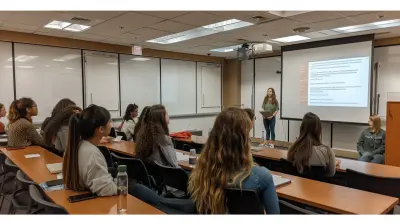Promoting Positive Self-Talk and Self-Reflection in Students
21 July 2025
Self-talk and self-reflection are the silent conversations we have in our minds. They shape our confidence, impact our learning, and influence our overall well-being. For students, fostering positive self-talk and meaningful self-reflection can be the key to unlocking their full potential. But how can we encourage this mindset in young learners?
Let’s dive in and explore how teachers, parents, and educators can support students in cultivating a stronger sense of self-awareness and positive inner dialogue. 
Why Positive Self-Talk Matters
Have you ever caught yourself saying, “I’m terrible at this” or “I’ll never get it right”? Now imagine students constantly feeding themselves similar negative thoughts. It can be detrimental to their confidence and academic performance.Positive self-talk is like having an encouraging best friend inside your head instead of a harsh critic. It helps students:
- Build resilience – Instead of giving up after failing a test, they’ll tell themselves, "I’ll study harder next time."
- Boost confidence – They begin to believe in their abilities and take on challenges with a positive mindset.
- Reduce stress and anxiety – A supportive inner voice can calm nerves before exams or presentations.
- Improve problem-solving skills – A growth mindset encourages students to look at challenges as opportunities rather than obstacles.
If we can help students rewrite their inner dialogue, we set them up for success inside and outside the classroom. 
The Power of Self-Reflection
If positive self-talk is the voice inside a student’s head, self-reflection is the process of listening to it and evaluating it. Self-reflection gives students the opportunity to:- Assess their progress and identify strengths
- Recognize areas for improvement without self-criticism
- Develop a growth mindset
- Enhance their decision-making and problem-solving skills
Reflection isn’t just about thinking. It’s about understanding how past experiences shape future outcomes and adjusting accordingly. 
Encouraging Positive Self-Talk in Students
So, how do we train students to turn their inner critic into a source of encouragement?1. Teach Them to Recognize Negative Self-Talk
The first step is awareness. Many students don’t even realize how often they talk negatively to themselves. Encourage them to pause and ask:- Would I say this to a friend?
- Is this thought helping me grow, or is it holding me back?
- What’s a more positive way to look at this?
When students start catching negative thoughts, they can begin replacing them with kinder, more constructive ones.
2. Provide Positive Affirmations
Affirmations are like mental workouts for self-esteem. When repeated often, they reshape thinking patterns. Share examples of affirmations students can use:- “I am capable of learning and growing.”
- “Mistakes help me improve.”
- “I am proud of my efforts and progress.”
- “I can handle challenges that come my way.”
Encourage them to write and say their own personalized affirmations daily.
3. Model Positive Self-Talk
Students mirror the behaviors of the adults around them. If they hear teachers and parents using positive self-talk, they’re more likely to adopt the habit themselves.For example, instead of saying, “I’m not good at technology,” a teacher could say, “I’m still learning how to use this new tool, and I’ll get better with practice.”
By modeling problem-solving rather than self-defeat, we teach students to approach challenges with confidence.
4. Reframe Challenges as Opportunities
Students often fear failure, but shifting their mindset can make a huge difference. Try guiding them through reframing techniques:❌ Negative Thought: “I’ll never understand math.”
✅ Reframed Thought: “Math is challenging, but I can improve if I keep practicing.”
Over time, students learn that setbacks are not roadblocks but stepping stones toward improvement. 
Encouraging Self-Reflection in Students
1. Create a Reflective Classroom Culture
Make self-reflection part of daily learning. At the end of each lesson, ask students:- What did I do well today?
- What could I improve next time?
- How did I overcome a challenge?
By consistently integrating these questions, reflection becomes second nature.
2. Use Journaling as a Self-Reflection Tool
Journaling gives students a private space to process their emotions, thoughts, and learning experiences. Provide prompts such as:- “What’s one thing I learned today that surprised me?”
- “How did I handle a difficult task today?”
- “What’s one way I can push myself out of my comfort zone tomorrow?”
Encouraging honesty in their reflections helps them develop a deeper understanding of themselves.
3. Promote Growth Mindset Language
Praising students for their efforts rather than just their results fosters a learning-focused mindset. Instead of saying:❌ "You're so smart!"
✅ "I love how hard you worked on that!"
This shift in language helps students see growth as an ongoing process rather than something fixed.
4. Encourage Peer Reflections
Sometimes students don’t recognize their own growth until they discuss it with others. Peer reflections, group discussions, or even “shout-out” sessions where they recognize classmates' progress can boost motivation.For example, weekly class discussions where students share something they’re proud of can reinforce the value of self-reflection.
The Role of Educators and Parents
Teachers: The Silent Architects of Mindset
Teachers play a crucial role in developing students' self-talk and reflection habits. By using encouraging language, setting high yet achievable expectations, and modeling self-reflection, they create an environment where students feel safe to learn and grow.A simple shift, such as providing constructive feedback instead of only pointing out mistakes, can shape a student’s self-perception in the long run.
Parents: Reinforcing Positive Self-Talk at Home
At home, parents can:- Remind their children of their progress and strengths.
- Encourage open conversations about setbacks and struggles.
- Praise effort and perseverance rather than just achievements.
Being mindful of the words we use around students can significantly shape how they see themselves.
Final Thoughts
Promoting positive self-talk and self-reflection in students isn’t about shielding them from failure—it’s about equipping them with the mindset to handle challenges in a healthy way.When students learn to be their own cheerleaders instead of their biggest critics, they develop the confidence to tackle any obstacle that comes their way.
By fostering these skills in the classroom and at home, we prepare students not just for academic success, but for a lifetime of growth, resilience, and self-confidence.
all images in this post were generated using AI tools
Category:
Social Emotional LearningAuthor:

Olivia Lewis
Discussion
rate this article
1 comments
Mara Roberson
How can we encourage daily practice?
August 5, 2025 at 11:35 AM

Olivia Lewis
Encourage daily practice by incorporating short, structured activities that promote self-talk and reflection into students' routines, such as journaling or mindfulness exercises.


